
Score Editor: Chili Notes

‚‚Kippfigur’ ist ein Begriff aus der Wahrnehmungspsychologie, welcher
eine optische Täuschung bezeichnet. Durch Änderung von
Perspektive und willkürlicher Augenbewegung gelingt es uns das
Bild „umzukippen“. Dieselbe äußere fixierte Form wird einmal
so und einmal anders wahrgenommen, ohne dass wir einen absoluten
Einfluss auf den Austauch-Prozess haben.
Der Reiz dieses Phänomens in der Musik zu übertragen, bestand
darin, die Aufmerksamkeit auf den Klang sowie auf die Stille zu
konzentrieren – auf den endotopischen (inneren) sowie auf den
exotopischen (äußeren) Bereich, wie es Paul Klee
nannte. Den Versuch die Idee der Doppeldeutigkeit umzusetzen, hat
zu einer Dichotomie zwischen einigen Parameter geführt. So sind
Klang und Stille oder die Ab- oder Anwesenheit des Tones es’ zu
verstehen. Dieser Ton von allen vier Saxophonen gespielt steht im
Mittelpunkt des Stückes. Die unterschiedliche Dauer jeder
einzelnen Stimme entwickeln eine Raumbewegung, die der Stille eine
Gestalt zufügt: die Stille bekommt dann einen Rhythmus und die
Tonlosigkeit ist nicht mehr die Abwesenheit von Klang, sondern der
Anfang der Stille.
Der Versuch eine solche visuelle Illusion in der Musik zum klingen zu
bringen, ist eine Herausforderung, die die Kreativität antreibt
und eine Metapher für mehrere kompositorische Entscheidungen.
Luís Antunes Pena
“Kippfigur” (in
English, counter changes) is a concept from the perception psychology
that denotes an optical illusion. By changing the perspective and
arbitrary movements of our eyes we are able to “flip over” the image.
The same figure at the paper will be double perceptioned without our
direct influence on the changing process.
The challenge to translate such a phenomena to the music was to
concentrate the attention not only on the sound but on the silence as
well – the endotopic (inside) and the exotopic (outside) area’s as
described by Paul Klee. The idea of the double meaning lead me to the
creation of a dichotomy between some parameters. Sound and silence, or
the absence and the presence of a single tone can be seen in this
context has a consequence of this idea. The note Eb3 plays a central
role in the whole piece. Played by all the saxophones, each one with
different durations, the end of the tone produces a space movement
assigning the silence a shape. Stillness is no longer the absence of
sound but the beginning of silence.
The attempt to make such a visual illusion sounding represents a
challenge that drives the creativity to look for compositional
decisions emerging like metaphors of the visual world.
Luís Antunes Pena